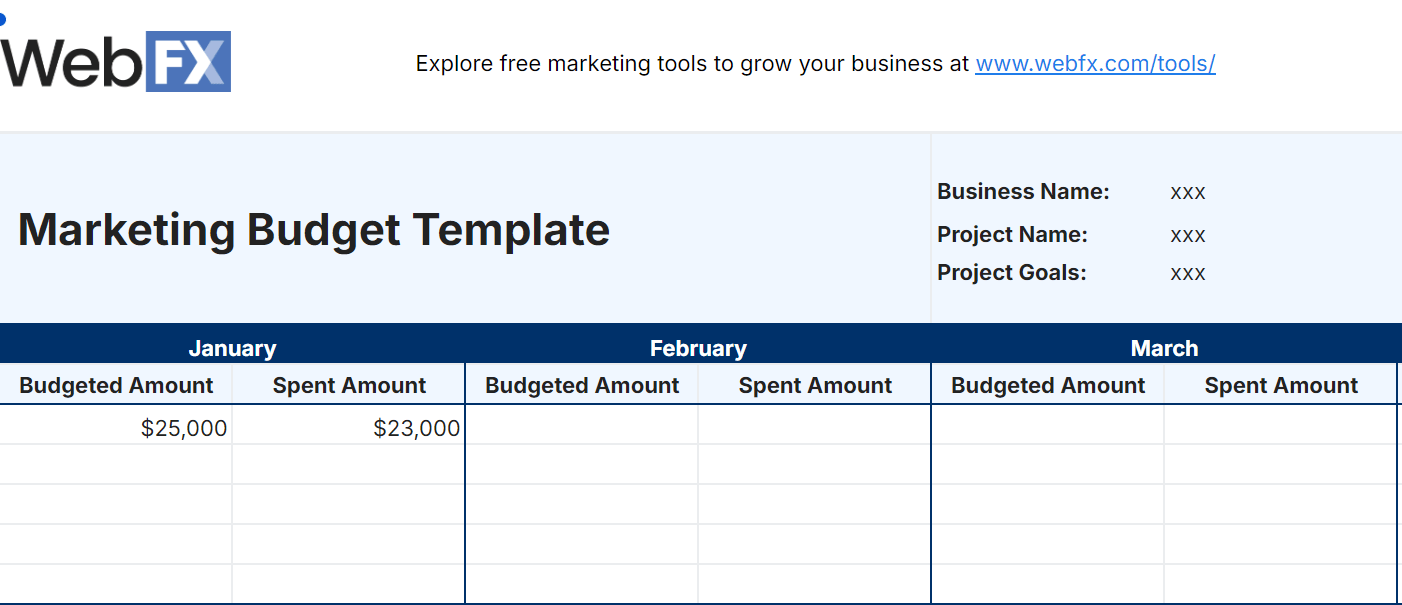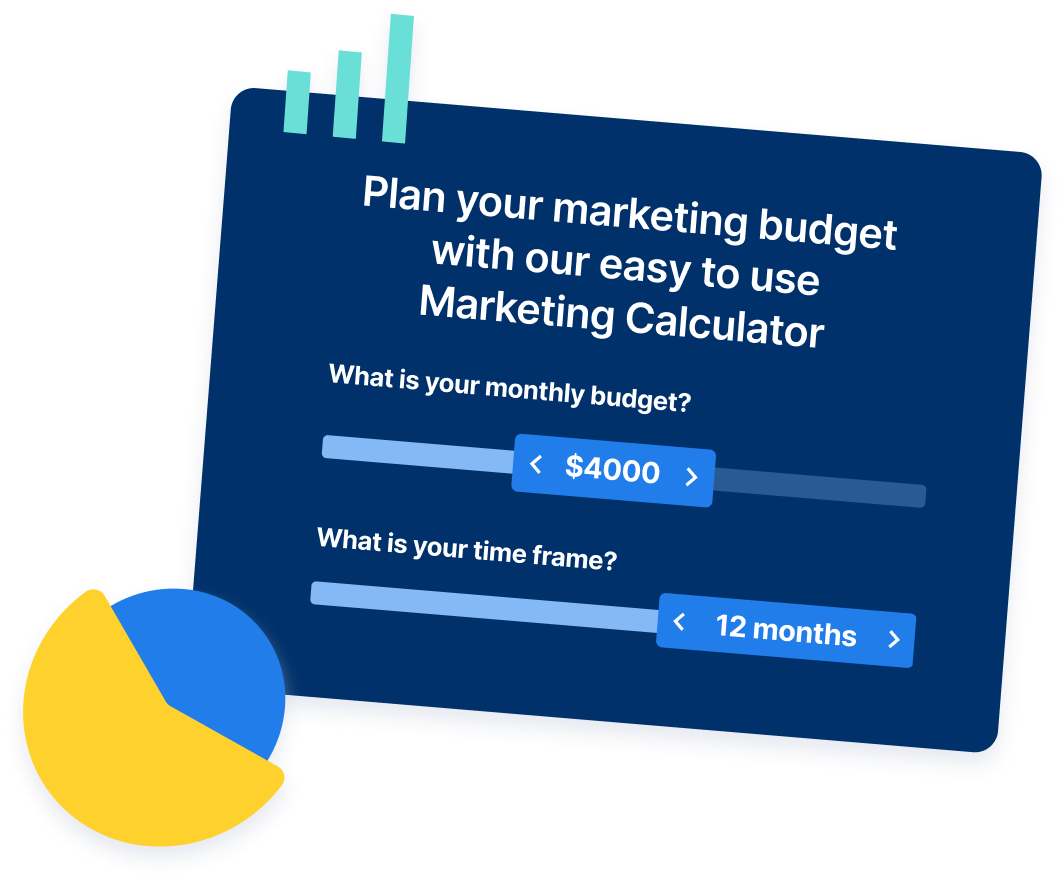-
 Published: Apr 1, 2025
Published: Apr 1, 2025
-
 13 min. read
13 min. read
-
 Maria Carpena
Maria Carpena Emerging Trends & Research Writer
Emerging Trends & Research Writer
- Maria is an experienced marketing professional in both B2C and B2B spaces. She’s earned certifications in inbound marketing, content marketing, Google Analytics, and PR. Her favorite topics include digital marketing, social media, and AI. When she’s not immersed in digital marketing and writing, she’s running, swimming, biking, or playing with her dogs.
What is a marketing budget?
A marketing budget is an outline of your specific, planned spending to market your products or services for a certain period.
Planning your marketing budget isn’t always a walk in the park. However, it’s crucial for every marketing leader to ensure their team is optimizing their marketing campaigns and monitoring the effectiveness of their strategies.
With the right marketing budget examples as your guide, you can effectively plan your budget and measure your return on investment (ROI).
In this blog post, we’ll go through marketing budget examples and templates to help you start planning yours. Here are the topics we’ll cover:
- How much should businesses spend on marketing?
- 8 marketing costs that marketers must consider
- Marketing budget plan breakdown
- 5 marketing budget examples
- Free marketing budget templates
- How to create a marketing budget
To learn more, you can download our guide for managing your marketing budget or use our free marketing budget calculator.
How much should businesses spend on marketing?
According to Statista, chief marketing officers surveyed in North America and Northern and Western Europe reported that, on average, 7.7% of their revenue was allotted to marketing.
When it comes to marketing budgets, though, there’s no single magical number for all businesses. Your budget will depend on a variety of factors, including:
- Location
- Growth rate
- Sales cycle
- Business goals
- Expenses for the year
- Competition
- Economic climate
- And more!
Two of the biggest factors, though, are business size and industry. Let’s look briefly at how each of those things affect your budget.
Average budget based on business size
Here’s a general guide for typical marketing budgets across different business sizes:
| Business size | Potential marketing budget based on a percentage of revenue |
| Small businesses | 7% to 8% |
| Medium-sized businesses | 10% |
| Enterprises | 15% |
Note that as your company experiences growth, your budget will likely change. Whenever your growth goals shift, you should reconsider how your budget is allocated.
Average budget based on industry
Here’s some information about how businesses typically allocate their budgets based on industry:
| INDUSTRY | PERCENT OF REVENUE TO SPEND ON MARKETING |
|---|---|
| Communications | 9% |
| Construction | 3% |
| Consulting | 8% |
| Consumer packaged goods | 9% |
| Consumer services | 19% |
| Education | 12% |
| Energy | 8% |
| Finance | 9% |
| Healthcare | 9% |
| Insurance | 9% |
| Manufacturing | 2% |
| Retail wholesale | 4% |
| Technology | 10% |
Of course, these are just averages. If you work in the technology sector, for instance, there’s no reason you have to devote exactly 10% of your revenue toward your marketing budget. You can devote much more than that, or much less, depending on your unique needs.
8 marketing costs that marketers must consider
Before creating your marketing budget plan, it’s a good idea to list the costs you’ll incur based on your marketing strategies. Here are some of the most common costs that marketers must consider:
- Branding
- Website design, development, and maintenance
- Content marketing
- Public relations
- Events and activations
- Digital advertising spend
- New employee, and freelancer or agency costs
- Technology and automation
Let’s go through each one.
1. Branding
Branding involves creating a unique identity for your business and offerings through your marketing messages, design, and customer journey.
Consider the following branding-related costs in your marketing budget:
- Market research
- Brand book development
- Visual style guide development
- Editorial style guide development
- Branding tools
2. Website design, development, and maintenance
A well-maintained website is essential for your digital marketing campaigns. Here are some of the website-related costs you need to include in your marketing budget:
- Website redesign (if you’re due for a redesign)
- Website development
- Website maintenance
- Content migration
- Domain name renewal
- Hosting
- Content management system
- Website tools and plugins
- Search engine optimization (SEO)
- Web design agency or freelancer fees
3. Content marketing
Content marketing is three times more effective at generating leads than outbound marketing. To effectively implement this strategy, you must factor these costs into your marketing budget:
- Content planning software (such as keyword research tools)
- Writing software (such as a grammar checker)
- Video production costs
- Content management and analytics tools
- Agency or freelancer fees
4. Public relations
Your public relations (PR) efforts manage how information about your brand is disseminated to the public by the media. Ensure you allocate enough resources to your PR campaigns by adding these costs to your marketing budget:
- Press release service
- PR tools (such as reputation monitoring software)
- Press release writing
- Events
- Media relations
- Newsletter tool
- Agency retainer fees
5. Events and activations
Events and activations are offline efforts to engage with your prospects.
If you’re launching new products or increasing your brand awareness, events and activations are excellent ways to provide an interactive experience. When done right, they can help convert prospects.
Here are some costs related to holding events:
- Program
- Venue
- Equipment
- Special on-site promotions
- Miscellaneous materials
- Agency and freelancer fees
6. Digital advertising spend
Based on your marketing and business goals, allocate how much money you’ll spend on the following:
- Search ads
- Display ads
- Affiliate marketing
- Social media ads
- Paid lead generation campaigns
- Agency or freelancer fees
- Campaign analytics tools
7. New employees and freelancer or agency costs
You may hire a freelancer or an agency when you’re trying a marketing strategy for the first time. Factor these costs into your marketing budget.
If you hire more full-time employees within the year, consider the costs associated with hiring them:
- New employees’ equipment and software
- Benefits
- Onboarding costs
- Salary
8. Technology and automation
One thing you don’t want to do is try to handle all of your marketing efforts manually. If you do, it’ll take forever, and you’ll fall way behind your competitors. Not to mention, your data analytics will be far less accurate.
The good news is, there are plenty of digital marketing tools out there you can take advantage of. Some of those tools are free, but most of them cost money — occasionally a one-time payment, but usually a subscription cost. Needless to say, you’ll need to make room for that in your budget.
Exactly how much you should spend on marketing tools depends on which tools you need. Take the time to figure out what kind of marketing technology is your priority, and then budget accordingly. Some of the main marketing tools you’ll likely want to have include:
- A customer relationship management (CRM) platform
- A content management system (CMS) for building your website
- Automation tools for social media and email marketing
- Project management tools
- And more!
Marketing budget plan breakdown
Now that you’ve identified the costs you must include in your marketing budget, you’ll need to allocate a percentage of your resources to your different marketing budget categories.
If your priority for a certain period is to increase brand awareness, you may need to allocate a bigger budget to your branding efforts during that period. Here is a sample breakdown of how your marketing budget might look per channel:
| Marketing cost | Percentage of your marketing budget |
| Branding | 30% |
| Content marketing | 20% |
| Paid advertising | 20% |
| PR, events, and activation | 5% to 10% |
| Human resources (employees, agency, and freelancers) | 10% |
| Software and tools | 10% |
Again, though, this is only a hypothetical example. Your own budget might look very different from the sample above. You’ll need to adjust your budget based on factors such as:
- Customer personas
- Sales cycle
- New product or service launches
- Economic conditions
As an example, high-ticket items such as automobiles and real estate properties may require businesses to have test drives or open-house events when they launch new offerings. As a result, they may need to increase their PR budget and paid advertising dollars.
Your marketing budget breakdown may also vary per year or season. You may shift your budget depending on the company’s goals each quarter, too.
In a recent survey we conducted among 500+ business leaders, respondents said that their top digital marketing goals were to increase revenue (68%) and sales (65%). While these are the main goals for most businesses, many companies also set goals to increase brand awareness, engagement, or website traffic.
So, depending on what goals your company wants to achieve, your budget may shift as needed to meet those goals.
5 marketing budget examples from companies
If you’re looking for some marketing budget inspiration from other companies, look no further. Below, we’ll take a brief look at some marketing budget examples from five different companies:
| Company | Marketing budget percentage of revenue | Period |
| Abercrombie & Fitch | 5% | Q1 2024 |
| Airbnb | 9.61% | 2023 |
| Nike | 7.96% | 2023 |
| Ford | 1.42% | 2023 |
| The New York Times | 6.54% | 2022 |
Let’s look at each one in a little more detail.
1. Abercrombie & Fitch
This publicly traded retailer announced that it used 5% of its total sales for its marketing efforts in the first quarter of 2024. Abercrombie & Fitch generated net sales of $1.02 billion during that period.
2. Airbnb
Airbnb invested $953 million in advertising efforts in 2023, according to a Statista report. Their marketing budget consisted of 9.61% of their total $9.92 billion in revenue for that year.
3. Nike
Nike invested about $4.06 billion into its global advertising and promotion activities in 2023, which was 8% of their total budget. The athletic apparel brand generated $51 billion in revenue in 2023.
4. Ford
In 2023, Ford budgeted $2.5 billion for marketing and advertising activities globally. Their investment was estimated to be 1.42% of their total revenue for 2023, which came out to nearly $176 billion.
5. The New York Times
The New York Times invested $151 million into their marketing efforts in 2022. That number made up an estimated 6.54% of their total $2.31 billion in revenue that year.
Marketing budget templates
Improve your budget management and track your marketing investment with the help of our free marketing budget templates. We created these two downloadable templates to make it easy for you to plan your budget and manage your resources.
1. Marketing budget plan template
This template helps you break down your marketing budget according to channel or strategy. Input the total allocated marketing budget. Then, based on your marketing goals, allot a percentage to each strategy or channel.

“*” indicates required fields
If not, click here.
“*” indicates required fields
If not, click here.
2. Marketing budget tracker template
Use this template to allocate your marketing dollars and track your spending monthly. This spreadsheet has one sheet per marketing category.
Input your allocated budget per cost item. Then, input the actual amount spent to monitor your spending.
![]()
“*” indicates required fields
If not, click here.
How to prepare a marketing budget
Now that you’ve looked at some marketing budget examples, it’s time to get started on creating your marketing budget plan. You can do that by following these steps:
- Determine your goals and strategies
- Identify and evaluate your current marketing investment
- Understand your sales cycle
- Identify and research costs
- Use marketing budget tools to distribute your resources
- Plan how you’ll measure your ROI
Read on to learn more.
1. Determine your goals and strategies
Before you bust out your marketing budget templates, the first step is to identify what you want to accomplish.
Establish your goals and strategies. That way, you can align your budget with your objectives and allot more dollars to strategies that help you achieve your most important goals.
Here are some goals you might focus on:
- Increasing brand awareness
- Growing your social media following
- Earning more reviews
- Growing your number of newsletter subscribers
- Increasing your number of leads
- Driving more sales
Make sure you set SMART goals (that is, goals that are Specific, Measurable, Achievable, Relevant, and Time-bound). For example, to increase sales, make the goal specific by indicating, “Increase sales by 10% year-over-year by December 2025.”
Once you’ve set your SMART goals, determine your marketing strategies. Align your strategies with your goals, ensuring they’ll help you achieve the results you want.
2. Identify and evaluate your current marketing investment
How much is your current investment in each marketing strategy? Take note of your current spending on each strategy, and then analyze how effective each strategy is by measuring its ROI.
Your analysis will determine whether you should pause a specific strategy or continue using it as you plan your budget.
3. Understand your sales cycle
How long is your sales cycle? What are the touchpoints and strategies you can invest in to convert your prospects? These are the questions you must answer as you evaluate your sales cycle. Understanding how long your sales cycle is and the sales process that your prospects go through informs you where you must allocate your marketing dollars.
Identify the touchpoints where you can nurture them into considering your brand, and invest in strategies to ease them into conversion.
For example, sales cycles for business-to-business (B2B) companies, such as software-as-a-service (SaaS) providers for dental clinics, are typically longer than that of business-to-consumer (B2C) firms. To increase brand awareness and make your SaaS business visible in every stage of the buyer’s journey, you can invest a portion of your budget in content marketing.
With content marketing, you can create informative pieces for your target audience at different stages of their journey. For example, you can create top-of-the-funnel (TOFU) content, such as a blog post about the benefits of using software for dental clinics.
You can also nurture your prospects who are in the middle of their journey and making a shortlist of SaaS providers. How? Publish case studies that show how your offerings have helped organizations retain customers and grow their practice.
4. Identify and research costs
The next step is to identify the costs associated with your marketing strategies.
Start by outlining any costs associated with your strategies. For example, let’s say you own a furniture shop that will launch a new collection within the year.
To increase awareness about your new offerings, you’re employing the following strategies: Content marketing, digital PR, and digital advertising. Each of those strategies comes with its own set of costs.
Here are some of the costs associated with content marketing for furniture shops:
- Content strategy
- Video strategy
- Video production
- Freelance writer
- Photographer fees
- Freelance artist’s fees
- Agency fees
You would want to draw up similar lists for digital PR and digital advertising.
Once you have a list of expenses associated with each strategy, research the price of each one. You can refer to your existing spending and also research other providers. You might, for example, review your past content marketing expenses and explore alternative providers.
5. Use marketing budget tools to distribute your resources
Now that you’ve identified your goals, strategies, and costs, you can use marketing budget templates and free calculators to allocate your monetary resources.
Use a marketing budget plan template to break down your dollars according to channels and strategies. Then you can use a marketing budget plan tracking template to monitor your spending and review your ROI.
6. Plan how you’ll measure your ROI
Think of your marketing budget as an investment in growing your business. You spend money on your marketing, but that money helps you earn even more revenue overall. Of course, this only works if you earn more than you spend, which is why it’s essential to measure your marketing return on investment (ROI).
For example, let’s say you invested in SEO services. You’d like to see an increase in site visitors and online inquiries. If your investment in these strategies provided the desired results, you’ll most likely want to continue your SEO efforts in the next year.
If the ROI of your SEO strategy is low, though, it means something isn’t right. That’s your cue to reevaluate your SEO strategy and figure out how to make it more effective at driving revenue. Until you figure that out, you may want to temporarily reduce the amount of your budget allocated to your SEO so you aren’t wasting your money.
Use an effective marketing budget plan to grow your business
These marketing budget examples and tips are handy when planning your budget and allocating resources to your various strategies. But it can still be a lot of work to do alone. If you’re looking to hire a marketing agency to help you grow your business, consider partnering with WebFX.
We’re a full-service digital marketing agency with 29 years of experience. Our team will take the time to understand your business, industry, and goals to craft effective strategies within your budget.
Contact us online or call us at 888-601-5359 to speak with a strategist about our digital marketing services!
-
 Maria is an experienced marketing professional in both B2C and B2B spaces. She’s earned certifications in inbound marketing, content marketing, Google Analytics, and PR. Her favorite topics include digital marketing, social media, and AI. When she’s not immersed in digital marketing and writing, she’s running, swimming, biking, or playing with her dogs.
Maria is an experienced marketing professional in both B2C and B2B spaces. She’s earned certifications in inbound marketing, content marketing, Google Analytics, and PR. Her favorite topics include digital marketing, social media, and AI. When she’s not immersed in digital marketing and writing, she’s running, swimming, biking, or playing with her dogs. -

WebFX is a full-service marketing agency with 1,100+ client reviews and a 4.9-star rating on Clutch! Find out how our expert team and revenue-accelerating tech can drive results for you! Learn more
Try our free Marketing Calculator
Craft a tailored online marketing strategy! Utilize our free Internet marketing calculator for a custom plan based on your location, reach, timeframe, and budget.
Plan Your Marketing Budget
Table of Contents
- How Much Should Businesses Spend on Marketing?
- Average Budget Based on Business Size
- Average Budget Based on Industry
- 8 Marketing Costs That Marketers Must Consider
- 1. Branding
- 2. Website Design, Development, and Maintenance
- 3. Content Marketing
- 4. Public Relations
- 5. Events and Activations
- 6. Digital Advertising Spend
- 7. New Employees and Freelancer or Agency Costs
- 8. Technology and Automation
- Marketing Budget Plan Breakdown
- 5 Marketing Budget Examples from Companies
- 1. Abercrombie & Fitch
- 2. Airbnb
- 3. Nike
- 4. Ford
- 5. New York Times
- Marketing Budget Templates
- 1. Marketing Budget Plan Template
- 2. Marketing Budget Tracker Template
- How to Prepare a Marketing Budget
- 1. Determine Your Goals and Strategies
- 2. Identify and Evaluate Your Current Marketing Investment
- 3. Understand Your Sales Cycle
- 4. Identify and Research Costs
- 5. Use Marketing Budget Tools to Distribute Your Resources
- 6. Plan How You’ll Measure Your ROI
- Use an Effective Marketing Budget Plan to Grow Your Business

Proven Marketing Strategies

Proven Marketing Strategies
Try our free Marketing Calculator
Craft a tailored online marketing strategy! Utilize our free Internet marketing calculator for a custom plan based on your location, reach, timeframe, and budget.
Plan Your Marketing Budget





